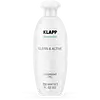What's inside
What's inside
 Benefits
Benefits

 Concerns
Concerns

 Ingredients Side-by-side
Ingredients Side-by-side

Water
Skin ConditioningGlycerin
HumectantHydrolyzed Soy Protein
HumectantBambusa Arundinacea Stem Extract
Skin ConditioningPEG-40 Hydrogenated Castor Oil
EmulsifyingPentylene Glycol
Skin ConditioningHydrolyzed Cottonseed Protein
Skin ConditioningCitrus Medica Limonum Fruit Extract
Skin ConditioningPlantago Major Leaf Extract
Skin ConditioningKrameria Triandra Root Extract
Skin ConditioningLavandula Angustifolia Oil
MaskingLitsea Cubeba Fruit Oil
MaskingCarbomer
Emulsion StabilisingButylene Glycol
HumectantSodium Hydroxide
BufferingCitric Acid
BufferingDisodium EDTA
Phenoxyethanol
PreservativeSorbic Acid
PreservativePotassium Sorbate
PreservativeCitral
PerfumingLinalool
PerfumingLimonene
PerfumingWater, Glycerin, Hydrolyzed Soy Protein, Bambusa Arundinacea Stem Extract, PEG-40 Hydrogenated Castor Oil, Pentylene Glycol, Hydrolyzed Cottonseed Protein, Citrus Medica Limonum Fruit Extract, Plantago Major Leaf Extract, Krameria Triandra Root Extract, Lavandula Angustifolia Oil, Litsea Cubeba Fruit Oil, Carbomer, Butylene Glycol, Sodium Hydroxide, Citric Acid, Disodium EDTA, Phenoxyethanol, Sorbic Acid, Potassium Sorbate, Citral, Linalool, Limonene
Water
Skin ConditioningCaprylic/Capric Triglyceride
MaskingSorbitol
HumectantPhenoxyethanol
PreservativePEG-40 Hydrogenated Castor Oil
EmulsifyingPEG-6 Stearate
EmulsifyingCarbomer
Emulsion StabilisingTrideceth-9
EmulsifyingGlycerin
HumectantSodium Hydroxide
BufferingEthylhexylglycerin
Skin ConditioningParfum
MaskingAloe Barbadensis Leaf Juice Powder
Skin ConditioningTetrasodium Glutamate Diacetate
Butylene Glycol
HumectantPropylene Glycol
HumectantSodium Benzoate
MaskingGlucose
HumectantUrtica Dioica Leaf Extract
Skin ConditioningPotassium Sorbate
PreservativeWater, Caprylic/Capric Triglyceride, Sorbitol, Phenoxyethanol, PEG-40 Hydrogenated Castor Oil, PEG-6 Stearate, Carbomer, Trideceth-9, Glycerin, Sodium Hydroxide, Ethylhexylglycerin, Parfum, Aloe Barbadensis Leaf Juice Powder, Tetrasodium Glutamate Diacetate, Butylene Glycol, Propylene Glycol, Sodium Benzoate, Glucose, Urtica Dioica Leaf Extract, Potassium Sorbate
Ingredients Explained
These ingredients are found in both products.
Ingredients higher up in an ingredient list are typically present in a larger amount.
Butylene Glycol (or BG) is used within cosmetic products for a few different reasons:
Overall, Butylene Glycol is a safe and well-rounded ingredient that works well with other ingredients.
Though this ingredient works well with most skin types, some people with sensitive skin may experience a reaction such as allergic rashes, closed comedones, or itchiness.
Learn more about Butylene GlycolCarbomer is a polymer of acrylic acid. Its main role is to create a gel consistency.
A high amount of carbomer can cause pilling or balling up of products. Don't worry, most products contain 1% or less of carbomer.
Glycerin is already naturally found in your skin. It helps moisturize and protect your skin.
A study from 2016 found glycerin to be more effective as a humectant than AHAs and hyaluronic acid.
As a humectant, it helps the skin stay hydrated by pulling moisture to your skin. The low molecular weight of glycerin allows it to pull moisture into the deeper layers of your skin.
Hydrated skin improves your skin barrier; Your skin barrier helps protect against irritants and bacteria.
Glycerin has also been found to have antimicrobial and antiviral properties. Due to these properties, glycerin is often used in wound and burn treatments.
In cosmetics, glycerin is usually derived from plants such as soybean or palm. However, it can also be sourced from animals, such as tallow or animal fat.
This ingredient is organic, colorless, odorless, and non-toxic.
Glycerin is the name for this ingredient in American English. British English uses Glycerol/Glycerine.
Learn more about GlycerinPeg-40 Hydrogenated Castor Oil is derived from castor oil and polyethylene glycol (PEG). It is used as a emollient and emulsifier.
As an emulsifier, it helps prevent ingredients from separating. It also helps make the other ingredients more soluble; it is often used to solubilize fragrances. This increases spreadability and elongates shelf life in a product.
Emollients help soothe and soften the skin. They do this by creating a protective film on your skin. This barrier helps trap moisture and keeps your skin hydrated. Emollients may be effective at treating dry or itchy skin.
This ingredient may or may not be vegan, depending on the source.
Peg-40 Hydrogenated Castor Oil may not be fungal-acne safe. We recommend speaking with a professional if you have any questions or concerns.
Learn more about PEG-40 Hydrogenated Castor OilPhenoxyethanol is a preservative that has germicide, antimicrobial, and aromatic properties. Studies show that phenoxyethanol can prevent microbial growth. By itself, it has a scent that is similar to that of a rose.
It's often used in formulations along with Caprylyl Glycol to preserve the shelf life of products.
Potassium Sorbate is a preservative used to prevent yeast and mold in products. It is commonly found in both cosmetic and food products.
This ingredient comes from potassium salt derived from sorbic acid. Sorbic acid is a natural antibiotic and effective against fungus.
Both potassium sorbate and sorbic acid can be found in baked goods, cheeses, dried meats, dried fruit, ice cream, pickles, wine, yogurt, and more.
You'll often find this ingredient used with other preservatives.
Learn more about Potassium SorbateSodium Hydroxide is also known as lye or caustic soda. It is used to adjust the pH of products; many ingredients require a specific pH to be effective.
In small amounts, sodium hydroxide is considered safe to use. However, large amounts may cause chemical burns due to its high alkaline.
Your skin has a natural pH and acid mantle. This acid mantle helps prevent harmful bacteria from breaking through. The acid mantle also helps keep your skin hydrated.
"Alkaline" refers to a high pH level. A low pH level would be considered acidic.
Learn more about Sodium HydroxideWater. It's the most common cosmetic ingredient of all. You'll usually see it at the top of ingredient lists, meaning that it makes up the largest part of the product.
So why is it so popular? Water most often acts as a solvent - this means that it helps dissolve other ingredients into the formulation.
You'll also recognize water as that liquid we all need to stay alive. If you see this, drink a glass of water. Stay hydrated!
Learn more about Water